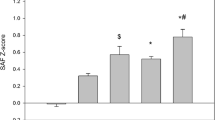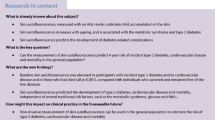Abstract
Background.ST-elevation myocardial infarction (STEMI) is associated with increased inflammation and oxidative stress, enhancing the formation of advanced glycation endproducts (AGEs). These encompass a characteristic fluorescence pattern, which can be non-invasively measured as skin autofluorescence (AF). In this study we investigate whether skin AF is elevated in STEMI, its association with inflammatory and glycaemic stress and its predictive value for future events.
Methods.Skin AF was measured in 88 STEMI patients (mean age 64±13 years) within 72 hours and around six months after discharge, in 81 stable coronary artery disease (sCAD) patients (64±10 years), and in 32 healthy controls (63±11 years). The cumulative one-year incidence of all-cause mortality and hospitalisation for myocardial infarction or heart failure was documented.
Results.Skin AF was significantly higher in STEMI compared with sCAD and controls, irrespective of confounders, and was associated with HbA1c and C-reactive protein. Skin AF decreased significantly in STEMI patients, when measured >200 days after discharge. In STEMI patients, skin AF above the median was predictive of future events (hazard ratio 11.6, 95% CI 1.5 to 90.8, p=0.019).
Conclusion.Skin AF is elevated in STEMI, is associated with inflammation and glycaemic stress, and predicts future major adverse cardiac events. (Neth Heart J 2009;17:162–8.)
Similar content being viewed by others
References
Stocker R, Keaney J. Role of oxidative modifications in atherosclerosis. Physiol Rev 2004;84:1381–478.
Walter M, Jacob R, Jeffers B, Ghadanfar M, Preston G, Buch J, et al. Serum levels of thiobarbituric acid reactive substances predict cardiovascular events in patients with stable coronary artery disease: a longitudinal analysis of the PREVENT study. J Am Coll Cardiol 2004;44:1996–2002.
Heitzer T, Schlinzig T, Krohn K, Meinertz T, Munzel T. Endothelial dysfunction, oxidative stress, and risk of cardiovascular events in patients with coronary artery disease. Circulation 2001;104: 2673–8.
Holvoet P, Collen D, Van de Werf F. Malondialdehyde-modified LDL as a marker of acute coronary syndromes. JAMA 1999;281: 1718–21.
Shimomura H, Ogawa H, Takazoe K, Soejima H, Miyamoto S, Sakamoto T, et al. Comparison of urinary biopyrrin levels in acute myocardial infarction (after reperfusion therapy) versus stable angina pectoris and their usefulness in predicting subsequent cardiac events. Am J Cardiol 2002;90:108–111.
Schwedhelm E, Bartling A, Lenzen H, Tsikas D, Maas R, Brummer J, et al. Urinary 8-iso-Prostaglandin F2{alpha} as a risk marker in patients with coronary heart disease: A matched casecontrol study. Circulation 2004; 109:843–8.
Smit A, Lutgers H. The clinical relevance of advanced glycation endproducts (AGE) and recent developments in pharmaceutics to reduce AGE accumulation. Curr Med Chem 2004;11:2767–84.
Baynes JW, Thorpe SR. Glycoxidation and lipoxidation in atherogenesis. Free Radic Biol Med 2000;28:1708–16.
Meerwaldt R, Hartog JW, Graaff R, Huisman RJ, Links TP, den Hollander NC, et al. Skin autofluorescence, a measure of cumulative metabolic stress and advanced glycation end products, predicts mortality in hemodialysis patients. J Am Soc Nephrol 2005;16:3687–93.
Meerwaldt R, Lutgers HL, Links TP, Graaff R, Baynes JW, Gans RO, et al. Skin autofluorescence is a strong predictor of cardiac mortality in diabetes. Diabetes Care 2007;30:107–12.
Mulder DJ, van Haelst PL, Gross S, de LK, Bijzet J, Graaff R, et al. Skin autofluorescence is elevated in patients with stable coronary artery disease and is associated with serum levels of neopterin and the soluble receptor for advanced glycation end products. Atherosclerosis 2007;197:217–23.
Meerwaldt R, Oomen PHN, Links TP, Gans ROB, Smit AJ, Graaff R, et al. Simple non-invasive assessment of advanced glycation endproduct accumulation. Diabetologia 2004;47:1324–30.
Meerwaldt R, Links T, Graaff R, Thorpe SR, Baynes JW, Hartog J, et al. Simple noninvasive measurement of skin autofluorescence. Ann N Y Acad Sci 2005;1043:290–8.
Mulder DJ, van Haelst PL, Graaff R, Smit AJ, Gans RO, Zijlstra F. Skin autofluorescence is an independent marker for acute myocardial infarction. Circulation 2005;112:U427.
Fu MX, Requena JR, Jenkins AJ, Lyons TJ, Baynes JW, Thorpe SR. The advanced glycation end product, Nepsilon-(carboxymethyl) lysine, is a product of both lipid peroxidation and glycoxidation reactions. J Biol Chem 1996;271:9982–6.
Hartog J, de Vries A, Lutgers H, Meerwaldt R, Huisman R, van Son W, et al. Accumulation of advanced glycation end products, measured as skin autofluorescence, in renal disease. Ann N Y Acad Sci 2005;1043:299–307.
Lutgers HL, Graaff R, Links TP, Ubink-Veltmaat LJ, Bilo HJ, Gans RO, et al. Skin autofluorescence as a noninvasive marker of vascular damage in patients with type 2 diabetes. Diabetes Care 2006;29:2654–9.
Meerwaldt R, Graaff R, Links T, Baynes JW, Navis G, Huisman R, et al. Skin autofluorescence, a noninvasive measure of advanced glycation end product accumulation, is a predictor of mortality in hemodialysis patients. Ann N Y Acad Sci 2005;1043:911.
Valgimigli M, Merli E, Malagutti P, Soukhomovskaia O, Cicchitelli G, Macri G, et al. Endothelial dysfunction in acute and chronic coronary syndromes: evidence for a pathogenetic role of oxidative stress. Arch Biochem Biophys 2003;420:255–61.
Horiuchi M, Tsutsui M, Tasaki H, Morishita T, Suda O, Nakata S, et al. Upregulation of vascular extracellular superoxide dismutase in patients with acute coronary syndromes. Arterioscler Thromb Vasc Biol 2004;24:106–11.
Wang XL, Adachi T, Sim AS, Wilcken DEL. Plasma extracellular superoxide dismutase levels in an Australian population with coronary artery disease. Arterioscler Thromb Vasc Biol 1998;18: 1915–21.
Vassalle C, Petrozzi L, Botto N, Andreassi MG, Zucchelli GC. Oxidative stress and its association with coronary artery disease and different atherogenic risk factors. J Intern Med 2004;256:308–15.
Ridker PM, Brown NJ, Vaughan DE, Harrison DG, Mehta JL. Established and emerging plasma biomarkers in the prediction of first atherothrombotic events. Circulation 2004;109:IV6–19.
Kanauchi M, Tsujimoto N, Hashimoto T. Advanced glycation end products in nondiabetic patients with coronary artery disease. Diabetes Care 2001;24:1620.
Kilhovd BK, Juutilainen A, Lehto S, Ronnemaa T, Torjesen PA, Birkeland KI, et al. High serum levels of advanced glycation end products predict increased coronary heart disease mortality in nondiabetic women but not in nondiabetic men: a population-based 18-year follow-up study. Arterioscler Thromb Vasc Biol 2005;25: 815–20.
Bierhaus A, Hofmann MA, Ziegler R, Nawroth PP. AGEs and their interaction with AGE-receptors in vascular disease and diabetes mellitus. I. The AGE concept. Cardiovasc Res 1998;37: 586–600.
Bucciarelli LG, Kaneko M, Ananthakrishnan R, Harja E, Lee LK, Hwang YC, et al. Receptor for advanced-glycation end products: key modulator of myocardial ischemic injury. Circulation 2006; 113:1226–34.
Forbes J, Yee L, Thallas V, Lassila M, Candido R, Jandeleit-Dahm K, et al. Advanced glycation end product interventions reduce diabetes-accelerated atherosclerosis. Diabetes 2004;53:1813–23.
Park L, Raman K, Lee K, Lu Y, Ferran L, Chow W, et al. Suppression of accelerated diabetic atherosclerosis by the soluble receptor for advanced glycation endproducts. Nat Med 1998;4:1025–31.
Wolffenbuttel BHR, Crijns FRL, Huijberts MSP, Swennen GNM, Boulanger CM, Poitevin P et al. Breakers of advanced glycation end products restore large artery properties in experimental diabetes. Proc Natl Acad Sci U S A 1998;95:4630–4.
Vlassara H, Cai W, Crandall J, Goldberg T, Oberstein R, Dardaine V, et al. Inflammatory mediators are induced by dietary glycotoxins, a major risk factor for diabetic angiopathy. Proc Natl Acad Sci U S A 2002;99:15596–601.
Liuzzo G, Biasucci LM, Rebuzzi AG, Maseri A, Grillo RL, Gallimore JR, et al. The prognostic value of C-reactive protein and serum amyloid A protein in severe unstable angina. N Engl J Med 1994;331:417–24.
Mulder DJ, Water TV, Lutgers HL, Graaff R, Gans RO, Zijlstra F, et al. Skin autofluorescence, a novel marker for glycemic and oxidative stress-derived advanced glycation endproducts: an overview of current clinical studies, evidence, and limitations. Diabetes Technol Ther 2006;8:523–35.
Odetti P, Pronzato MA, Noberasco G, Cosso L, Traverso N, Cottalasso D, et al. Relationships between glycation and oxidation related fluorescences in rat collagen during aging. An in vivo and in vitro study. Lab Invest 1994;70:61–7.
Author information
Authors and Affiliations
Corresponding author
Additional information
Department of Internal Medicine, University Medical Center Groningen, Groningen, the Netherlands
Department of Cardiology, Antonius Hospital, Sneek, the Netherlands
Department of Biomedical-Engineering, University Medical Center Groningen, Groningen, the Netherlands
Department of Internal Medicine, University Medical Center Groningen, Groningen, the Netherlands
Department of Cardiology, University Medical Center Groningen, Groningen, the Netherlands
Department of Internal Medicine, University Medical Center Groningen, Groningen, the Netherlands
D.J. Mulder Department of Internal Medicine, University Medical Center Groningen, PO Box 30.001, 9700 RB Groningen, the Netherlands
Rights and permissions
About this article
Cite this article
Mulder, D.J., van Haelst, P.L., Graaff, R. et al. Skin autofluorescence is elevated in acute myocardial infarction and is associated with the one-year incidence of major adverse cardiac events. NHJL 17, 162–168 (2009). https://doi.org/10.1007/BF03086239
Issue Date:
DOI: https://doi.org/10.1007/BF03086239




